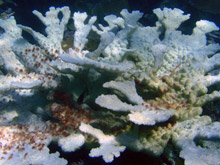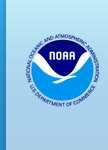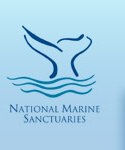Scientific Surveys Show Extent of Cold Impact on Florida Keys Corals
Feb. 25, 2010
The influx of cold water from Florida and Biscayne bays appears to be responsible for January’s coral deaths in nearshore waters of the Florida Keys National Marine Sanctuary, according to an assessment by reef biologists. Fortunately, offshore reefs most frequented by divers and sportfishers were buffered by the warmer waters of the Florida Current and spared severe impact.
Thirty one scientists representing 13 organizations surveyed 78 sites throughout the Florida reef tract from Martin County south through the lower Florida Keys, assessing coral health in the wake of record low temperatures. Their surveys, conducted Jan. 25 - Feb. 12, revealed that the inshore and mid-channel reefs from Biscayne Bay to Summerland Key were the hardest hit.
During the first two weeks of January, water temperatures in some parts of the Keys dropped into the frigid upper 40s and lower 50s — about 20 degrees lower than the typical temperatures of the upper 60s and lower 70s. The lethal lower limit for corals is 60 degrees.
A widespread cold-water coral die-off hasn’t occurred in Florida since the late 1970s.
While all coral species were affected, the impact of the cold water was very distinct from location to location.
“Corals within 100 meters of each other experienced 10- to 15-degree temperature differences,” said The Nature Conservancy’s James Byrne, marine science program manager.
The Florida Keys sit at the intersection of the warm tropical waters of the Caribbean and the cooler temperate waters of the Gulf of Mexico and the Atlantic Ocean. Water normally changes tidally between the two through channels between the islands. In January, those channels brought in cooler water from Florida and Biscayne bays, resulting in more dramatic temperature drops and subsequent coral death.
The Florida Reef Resilience team, a multi-organization effort spearheaded by The Nature Conservancy, is normally mobilized for surveys following warm-water bleaching events. “This rare cold-water data will help us know more in the long term about protecting these critical habitats,” said Byrne, whose agency tabulated the results.
One critical area researchers are still studying is whether this cold stress event will make corals more susceptible to disease. Research by Dr. Kim Ritchie, manager of Mote Marine Laboratory’s Coral Microbiology Program, has shown that some bacteria living symbiotically with corals help protect corals from disease. Following warm-water bleaching, corals’ bacterial makeup changes, leaving coral susceptible to disease.
“This cold event allows us to study coral response and recovery to a type of stress that is the opposite of the warming events we’ve been studying for the past three decades,” Ritchie said. “In this case, we’ll be documenting the balance of coral pathogens versus beneficial microbes during the recovery and be able to compare and contrast them for cold and warm events.”
Florida Keys National Marine Sanctuary, the manager of most Florida Keys coral reef resources, is working with the science community and limiting certain consumptive activities in the hardest hit areas until stressful conditions subside.
Program partners include The Nature Conservancy, Mote Marine Laboratory, Florida Keys National Marine Sanctuary, the National Park Service, Florida Department of Environmental Protection, Florida’s Fish and Wildlife Conservation Commission, the University of Miami, Nova Southeastern University, John Pennekamp Coral Reef State Park, Broward County and Miami-Dade County.
Divers in the Florida Keys are encouraged to report the location of observed coral bleaching to Mote’s BleachWatch program at www.mote.org/bleachwatch. This early-warning network helps alert managers to major disturbances. Divers should also be aware that bleached corals are extremely vulnerable to additional stress. Divers are encouraged to seek non-stressed areas – including wrecks, artificial reefs and offshore reefs – to enjoy at this time and, as always, to pay careful attention not to touch corals.
The coral reefs of the Florida Keys are the basis of a unique and diverse ecosystem that forms the third largest barrier reef in the world. Reef-related expenditures generate more than $4.4 billion annually in southeast Florida and reef recreation supports more than 70,000 jobs (2001).
Established in 1951, The Nature Conservancy is a leading conservation organization working around the world to protect ecologically important lands and waters for nature and people. In Florida, the Conservancy has helped protect more than 1.2 million acres. Visit The Nature Conservancy on the Web at www.nature.org.
Established in 1990, Florida Keys National Marine Sanctuary protects 2,900 square nautical miles of important marine habitat, including maritime heritage resources, as well as coral reef, hard bottom, seagrass meadows, mangrove communities and sand flats. National Oceanic and Atmospheric Administration (NOAA) and the state of Florida manage the sanctuary.
Founded in 1955, Mote Marine Laboratory is an independent nonprofit marine research organization based in Sarasota, Fla., with field stations in eastern Sarasota County, Charlotte Harbor and Summerland Key and Key West. Mote is dedicated the study of marine and estuarine ecosystems through seven research centers. Showcasing this research is Mote Aquarium, open from 10 a.m. to 5 p.m. 365 days a year. Learn more at www.mote.org. Help protect corals reefs. Learn how at www.mote.org/4reef.



